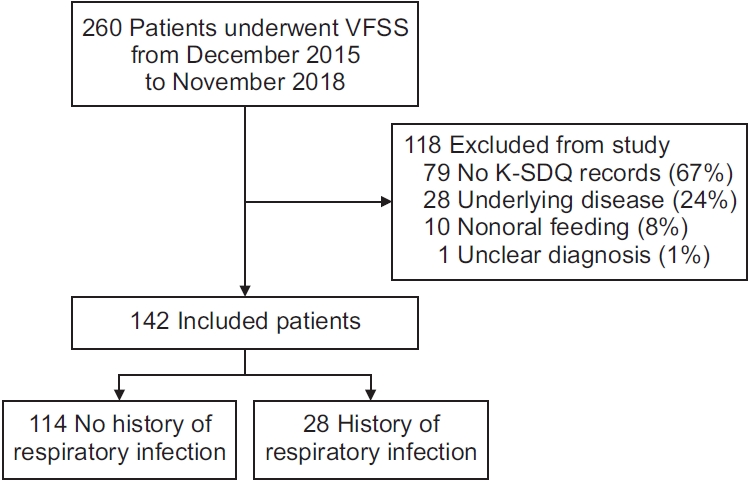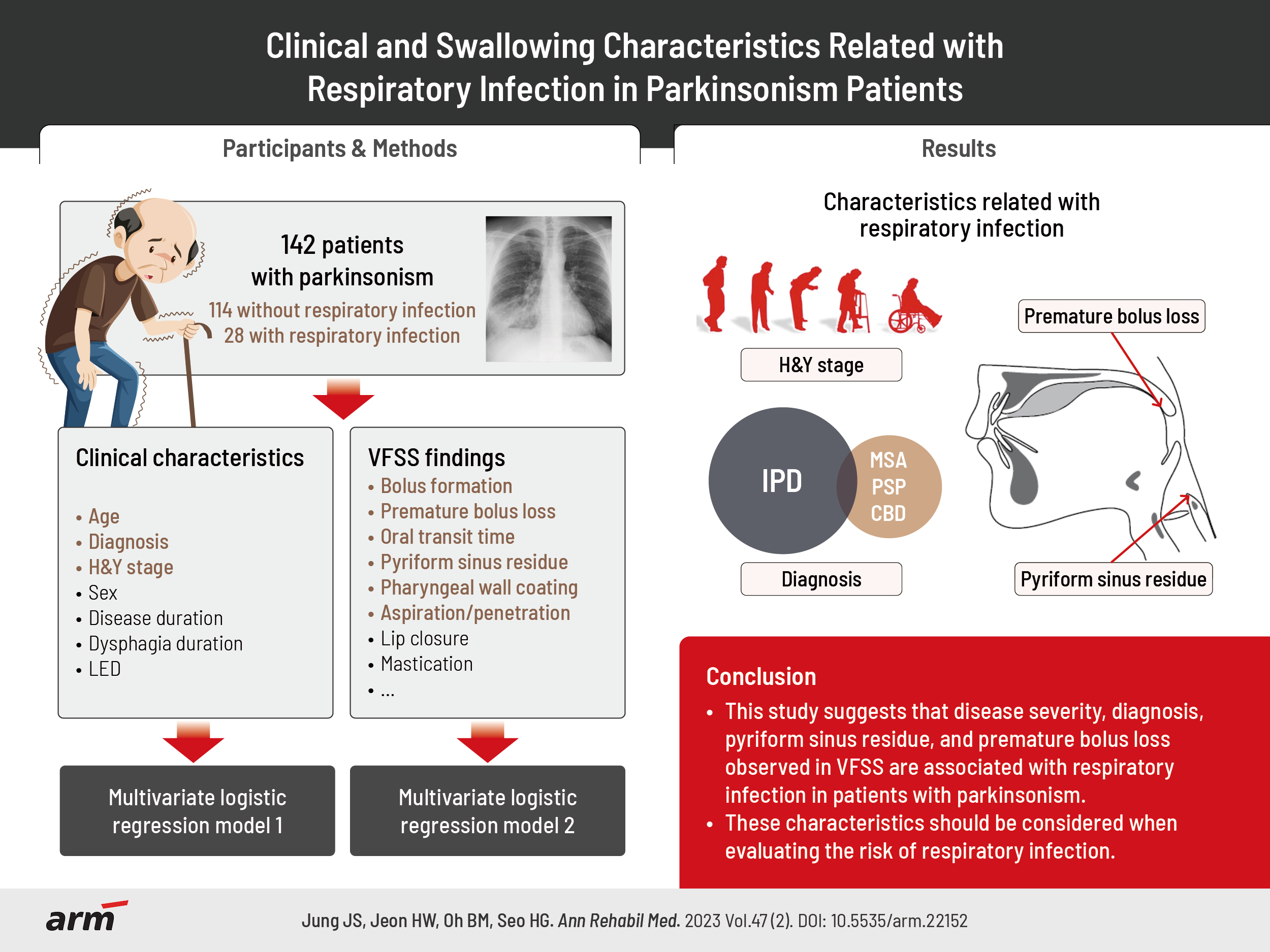- Search
| Ann Rehabil Med > Volume 47(2); 2023 > Article |
|
Abstract
Objective
Methods
Results
CONFLICTS OF INTEREST
Byung-Mo Oh is the Editor-in-Chief of Annals of Rehabilitation Medicine. Han Gil Seo is an Associate Editor of Annals of Rehabilitation Medicine. The authors did not engage in any part of the review and decision-making process for this manuscript. Otherwise, no potential conflict of interest relevant to this article was reported.
AUTHOR CONTRIBUTION
Conceptualization: Jung JS, Jeon H, Oh BM, Seo HG. Methodology: Jung JS, Jeon H, Oh BM, Seo HG. Formal analysis: Jung JS, Jeon H, Seo HG. Funding acquisition: Oh BM. Project administration: Seo HG. Visualization: Seo HG. Writing вҖ“ original draft: Jung JS. Writing вҖ“ review and editing: Seo HG. Approval of final manuscript: all authors.
ACKNOWLEDGMENTS
Fig.В 1.

TableВ 1.
| Variable | Patient (n=142) | No history of respiratory infection (n=114) | History of respiratory infection (n=28) | p-value | |
|---|---|---|---|---|---|
| Age (yr) | 71.50Вұ9.22 | 70.70Вұ8.83 | 74.75Вұ10.20 | 0.037* | |
| Sex | 0.140 | ||||
| Male | 84 (59.2) | 64 (56.1) | 20 (71.4) | ||
| Female | 58 (40.8) | 50 (43.9) | 8 (28.6) | ||
| Diagnosis | 0.011* | ||||
| IPD | 66 (46.5) | 47 (41.2) | 19 (67.9) | ||
| Atypical parkinsonism | |||||
| MSA | 30 (21.1) | 28 (24.6) | 2 (7.1) | ||
| PSP | 22 (15.5) | 18 (15.8) | 4 (14.3) | ||
| CBD | 2 (1.4) | 2 (1.8) | 0 | ||
| DLB | 2 (1.4) | 2 (1.8) | 0 | ||
| Not defined | 20 (14.1) | 17 (14.9) | 3 (10.7) | ||
| Duration, disease (yr) | 5.00 (6) | 5.00 (6) | 5.50 (6) | 0.744 | |
| Duration, dysphagia (yr) | 1.00 (3) | 1.00 (3) | 1.00 (3) | 0.423 | |
| Hoehn and Yahr stage | 0.047* | ||||
| IвҖ“III | 66 (46.5) | 58 (50.9) | 8 (28.5) | ||
| IVвҖ“V | 75 (52.8) | 56 (49.1) | 19 (67.9) | ||
| Not defined | 1 (0.7) | 0 | 1 (3.6) | ||
| LED (mg) | 686.00 (580.00) | 680.00 (590.00) | 760.00 (562.50) | 0.806 | |
TableВ 2.
| No history of respiratory infection (n=114) | History of respiratory infection (n=28) | p-value | |
|---|---|---|---|
| Lip closure (intact/inadequate+none) | 100/14 (12.3) | 21/7 (25.0) | 0.133 |
| Bolus formation (intact/inadequate+none) | 44/70 (61.4) | 4/24 (85.7) | 0.015* |
| Mastication (intact/inadequate+none) | 45/69 (60.5) | 7/21 (75.0) | 0.192 |
| Apraxia (none/mild+moderate+severe) | 104/10 (8.8) | 23/5 (17.9) | 0.176 |
| Tongue to palate contact (intact/inadequate+none) | 74/40 (35.1) | 16/12 (42.9) | 0.513 |
| Premature bolus loss (none/<10%/10%вҖ“50%/>50%) | 50/35/24/5 (56.1) | 9/4/11/4 (67.9) | 0.025* |
| Oral transit time (вүӨ1.5 s/>1.5 s) | 101/13 (11.4) | 20/8 (28.6) | 0.035* |
| Triggering of pharyngeal swallow (normal/delayed) | 65/49 (43.0) | 12/16 (57.1) | 0.207 |
| Vallecular residue (none/<10%/10%вҖ“50%/>50%) | 51/20/32/11 (55.3) | 9/4/10/5 (67.9) | 0.116 |
| Laryngeal elevation (normal/impaired) | 19/95 (83.3) | 2/26 (92.9) | 0.250 |
| Pyriform sinus residue (none/<10%/10%вҖ“50%/>50%) | 69/28/15/2 (39.5) | 10/10/4/4 (64.3) | 0.010* |
| Coating of pharyngeal wall (no/yes) | 64/50 (43.9) | 9/19 (67.9) | 0.034* |
| Pharyngeal transit time (вүӨ1.0 s/>1.0 s) | 93/21 (18.4) | 21/7 (25.0) | 0.434 |
| Aspiration (none/supraglottic penetration/subglottic aspiration) | 15/51/48 (86.8) | 1/9/18 (96.4) | 0.027* |
TableВ 3.
|
Multivariable analysis |
||
|---|---|---|
| Odds ratio (95% confidence interval) | p-value | |
| Hoehn and Yahr stage | ||
| вҖғIвҖ“III | Reference | |
| вҖғIVвҖ“V | 3.174 (1.226вҖ“8.216) | 0.017* |
| Diagnosis | ||
| вҖғIdiopathic ParkinsonвҖҷs disease | Reference | |
| вҖғAtyplical parkinsonism | 0.280 (0.111вҖ“0.706) | 0.007* |
TableВ 4.
|
Multivariable analysis |
||
|---|---|---|
| Odds ratio (95% confidence interval) | p-value | |
| Pyriform sinus residue (%) | ||
| вҖғNone | Reference | |
| вҖғ<10 | 2.614 (0.917вҖ“7.454) | 0.072 |
| вҖғ10вҖ“50 | 1.807 (0.455вҖ“7.173) | 0.401 |
| вҖғ>50 | 14.615 (2.257вҖ“94.623) | 0.005* |
| Premature bolus loss (%) | ||
| вҖғNone | Reference | |
| вҖғ<10 | 0.600 (0.158вҖ“2.287) | 0.455 |
| вҖғ10вҖ“50 | 1.840 (0.602вҖ“5.623) | 0.285 |
| вҖғ>50 | 5.151 (1.047вҖ“25.338) | 0.044* |
| Oral transit time (s) | ||
| вҖғ<1.5 | Reference | |
| вҖғвүҘ1.5 | 2.672 (0.854вҖ“8.364) | 0.091 |
REFERENCES
- TOOLS
-
METRICS

-
- 0 Crossref
- Scopus
- 1,683 View
- 84 Download
- Related articles in ARM
-
Clinical and Statistical Observation in Occupational Burned Patients1994 June;18(2)
Phonological Characteristics in Parkinson's Disease.1998 June;22(3)
Kinetic Characteristics during Initiation of Gait in Stroke Patients.2001 April;25(2)







